Gettysburg, Battle of, fought from July 1 through July 3, 1863, marked a turning point in the American Civil War in the North's favor. General George G. Meade led a Northern army of about 90,000 men to victory against General Robert E. Lee's Southern army of about 75,000. The shooting began when the two forces met accidentally in the town of Gettysburg, Pennsylvania, on July 1.
That day, Southern forces took the town. But Union troops took a strong position on high ground south of town. On July 2, Lee tried but failed to break the North's line at points known as Culp's Hill, Cemetery Ridge, the Peach Orchard, the Wheatfield, Devil's Den, and Little Round Top. Early on July 3, fighting resumed at Culp's Hill, on the Union's right. Lee also attacked the Union's center, on Cemetery Ridge. Following an artillery duel, about 13,000 troops organized and in part led by General George E. Pickett advanced across an open field and up Cemetery Ridge in what became known as "Pickett's charge." Facing impossible odds, only a few of the Southern troops reached the top of the ridge. On July 4, Lee began to withdraw to Virginia.
About 4,000 Southerners and more than 3,000 Northerners were killed in the battle. The total number of casualties--those killed, wounded, missing, or captured--was about 23,000 for the North and from 25,000 to 28,000 for the South.
Gettysburg Address is a short speech that United States President Abraham Lincoln delivered during the American Civil War at the site of the Battle of Gettysburg in Pennsylvania. He delivered the address on Nov. 19, 1863, at ceremonies to dedicate a part of the battlefield as a cemetery for those who had lost their lives in the battle. Lincoln wrote the address to help ensure that the battle would be seen as a great Union triumph and to define for the people of the Northern States the purpose in fighting the war. Some historians think his simple and inspired words, which are among the best remembered in American history, reshaped the nation by defining it as one people dedicated to one principle--that of equality.
Lincoln wrote five different versions of the speech. He wrote most of the first version in Washington, D.C., and probably completed it at Gettysburg. He probably wrote the second version at Gettysburg on the evening before he delivered his address. He held this second version in his hand during the address. But he made several changes as he spoke. The most important change was to add the phrase "under God" after the word "nation" in the last sentence. Lincoln also added that phrase to the three versions of the address that he wrote after the ceremonies at Gettysburg.
Lincoln wrote the final version of the address--the fifth written version--in 1864. This version also differed somewhat from the speech he actually gave, but it was the only copy he signed. It is carved on a stone plaque in the Lincoln Memorial.
Many false stories have grown up about this famous speech. One story says that the people of Lincoln's time did not appreciate the speech. But the reaction of the nation's newspapers largely followed party lines. Most of the newspapers that backed the Republican Party, the party to which Lincoln belonged, liked the speech. A majority of the newspapers that supported the Democratic Party did not. Edward Everett, the principal speaker at the dedication, wrote to Lincoln: "I should be glad if I could flatter myself that I came as near to the central idea of the occasion in two hours as you did in two minutes."
Fifth written version
Four score and seven years ago our fathers brought forth on this continent, a new nation, conceived in Liberty, and dedicated to the proposition that all men are created equal.
Now we are engaged in a great civil war, testing whether that nation, or any nation so conceived and so dedicated, can long endure. We are met on a great battlefield of that war. We have come to dedicate a portion of that field, as a final resting place for those who here gave their lives that that nation might live. It is altogether fitting and proper that we should do this.
But, in a larger sense, we can not dedicate--we can not consecrate--we can not hallow--this ground. The brave men, living and dead, who struggled here, have consecrated it, far above our poor power to add or detract. The world will little note, nor long remember what we say here, but it can never forget what they did here. It is for us the living, rather, to be dedicated here to the unfinished work which they who fought here have thus far so nobly advanced. It is rather for us to be here dedicated to the great task remaining before us--that from these honored dead we take increased devotion to that cause for which they gave the last full measure of devotion--that we here highly resolve that these dead shall not have died in vain--that this nation, under God, shall have a new birth of freedom--and that government of the people, by the people, for the people, shall not perish from the earth.
Reporter's shorthand version
Four score and seven years ago our fathers brought forth upon this continent a new nation, conceived in Liberty, and dedicated to the proposition that all men are created equal.
Now we are engaged in a great civil war, testing whether that nation or any nation so conceived and so dedicated can long endure. We are met on a great battlefield of that war. We are met to dedicate a portion of it as the final resting place of those who here gave their lives that that nation might live. It is altogether fitting and proper that we should do this.
But in a larger sense we cannot dedicate--we cannot consecrate--we cannot hallow this ground. The brave men living and dead who struggled here have consecrated it far above our poor power to add or detract. The world will little note nor long remember what we say here, but it can never forget what they did here. It is for us, the living, rather to be dedicated here to the unfinished work that they have thus far so nobly carried on. It is rather for us to be here dedicated to the great task remaining before us--that from these honored dead we take increased devotion to that cause for which they here gave the last full measure of devotion--that we here highly resolve that the dead shall not have died in vain--that the nation shall, under God, have a new birth of freedom--and that governments of the people, by the people, and for the people, shall not perish from the earth.
When the armies marched away from Gettysburg they left behind a community in shambles and more than 51,000 killed, wounded, and missing. Wounded and dying were crowded into nearly every building. Most of the dead lay in hasty and inadequate graves; some had not been buried at all.
This situation so distressed Pennsylvania's Gov. Andrew Curtin that he commissioned a local attorney, David Wills, to purchase land for a proper burial ground for Union dead. Within four months of the battle, reinterment began on 17 acres that became Gettysburg National Cemetery.
When the cemetery was dedicated on November 19, 1863, less than half the Union battle dead had been removed from their field graves. The principal speaker was the renowned orator, Edward Everett. As was common for the day, his detailed speech lasted for over two hours.
Also on the program was a guest who had been invited to present "a few appropriate remarks" only as an afterthought. President Abraham Lincoln's delivery of these remarks lasted only two minutes that day. The short length was in such contrast to the Everett allocution that the audience, stunned for a moment, barely reacted. Upon returning to his seat Lincoln remarked to a friend: "That speech won't scour. It is a flat failure." To the contrary, the Gettysburg Address has become known as one of the supreme masterpieces of eloquence in the English language. On November 20, Everett wrote Lincoln "I should be glad if I could flatter myself that I came as near to the central idea of the occasion in two hours as you did in two minutes."
The 272 words of the Gettysburg Address were formulated with great thought by Lincoln. He wrote the first draft in Washington shortly before November 18 and revised it at the home of David Wills in Gettysburg the night before the dedication.
The speech transformed Gettysburg from a scene of carnage into a symbol, giving meaning to the sacrifice of the dead and inspiration to the living.
Within a few years, however, the bodies of more than 3,500 Union soldiers killed in the battle had been reinterred in the cemetery. Following the war, the remains of 3,320 Confederate soldiers were removed from the battlefield to cemeteries in the South.
Today the cemetery is the final resting place for over 6,000 honorably discharged servicemen and their dependents from the Civil War, Spanish-American War, World War I, World War II and the Vietnam War.
Lincoln could also write with down-home humor as demonstrated by this doggerel, which he wrote on July 19, 1863, two weeks after the Battle of Gettysburg.
General Lee's Invasion of the North
In eighteen sixty three,
with pomp,and mighty swell,
Me and Jeff's Confederacy,
went forth to sack Phil-del,
The Yankees they got arter us,
and giv us particular hell,
And we skedaddled back again,
and didn't sack Phil-del.
Throughout the world, Gettysburg is known for its role in the American Civil War and President Lincoln's Gettysburg Address. Far fewer know what our area was like before the battle or even further back, when the first European settlers arrived.
The land that now comprises the center of Adams County was purchased from the Iroquois Indians by the family of William Penn in 1736. At the time there was no official Gettysburg, Adams County, state of Pennsylvania or United States. Within a few years 150 families had "leap-frogged" over the English Quakers and Germans, who had settled to the east of here, to this area, then known by the name of its main tributary, Marsh Creek. Many of these settlers were Scots-Irish who had left Northern Ireland to escape English persecution.
One early settler, Samuel Gettys, established a tavern in 1761. By 1786 his son James had laid out a town of 210 lots with a central town square on the land surrounding the tavern. This town would become known as Gettysburg.
At that time, a trip to the county seat of York took an entire day and the differences in nationalities and religions of the eastern settlers were producing difficulties.
With the first Pennsylvania Frame of Government in 1776 and the Constitution of the United States in 1787, the growing population of the area decided they wanted to separate from York County. A new county was approved by the state legislature in 1800 (the year 2000 will be our bicentennial) and was named after the President at that time, John Adams. Gettysburg was chosen as the county seat.
By 1860 the town of Gettysburg had grown to 2,400 inhabitants with ten roads leading into the town, helping to create a few small but thriving industries. These roads and businesses would lead two armies into the county in 1863. At the time of the Battle of Gettysburg, there were about 450 buildings housing carriage manufacturing, shoemakers and tanneries as well as the usual merchants, banks and taverns of a county seat.
Many artifacts of this early period are on display at the Adams County Historical Society. The museum and archives are open Saturday 9-5 and Wednesday 1-5 and can be contacted at 111 North West Confederate Avenue, Gettysburg (717) 334-4723.
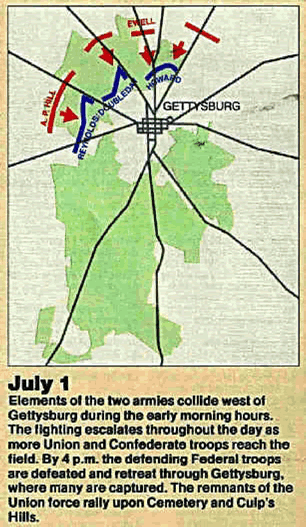
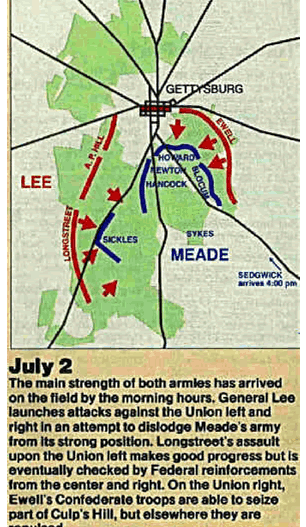
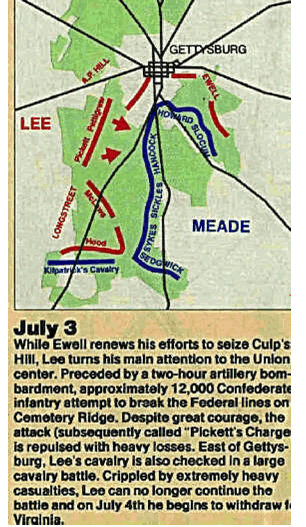
This most famous and most important Civil War Battle occurred over three hot summer days, July 1 to July 3, 1863, around the small market town of Gettysburg, Pennsylvania. It began as a skirmish but by its end involved 160,000 Americans.
Before the battle, major cities in the North such as Philadelphia, Baltimore and even Washington were under threat of attack from General Robert E. Lee's Confederate Army of Northern Virginia which had crossed the Potomac River and marched into Pennsylvania.
The Union Army of the Potomac under its very new and untried commander, General George G. Meade, marched to intercept Lee.
On Tuesday morning, June 30, an infantry brigade of Confederate soldiers searching for shoes headed toward Gettysburg (population 2,400). The Confederate commander looked through his field glasses and spotted a long column of Federal cavalry heading toward the town. He withdrew his brigade and informed his superior, Gen. Henry Heth, who in turn told his superior, A.P. Hill, he would go back the following morning and "get those shoes."
Wednesday morning, July 1, two divisions of Confederates headed back to Gettysburg. They ran into Federal cavalry west of the town at Willoughby Run and the skirmish began. Events would quickly escalate. Lee rushed 25,000 men to the scene. The Union had less than 20,000.
After much fierce fighting and heavy casualties on both sides, the Federals were pushed back through the town of Gettysburg and regrouped south of the town along the high ground near the cemetery. Lee ordered Confederate General R.S. Ewell to seize the high ground from the battle weary Federals "if practicable." Gen. Ewell hesitated to attack thereby giving the Union troops a chance to dig in along Cemetery Ridge and bring in reinforcements with artillery. By the time Lee realized Ewell had not attacked, the opportunity had vanished.
Meade arrived at the scene and thought it was an ideal place to do battle with Lee's Army. Meade anticipated reinforcements totaling up to 100,000 men to arrive and strengthen his defensive position.
Confederate General James Longstreet saw the Union position as nearly impregnable and told Lee it should be left alone. He argued that Lee's Army should instead move east between the Union Army and Washington and build a defensive position thus forcing the Federals to attack them instead.
But Lee believed his own army was invincible and he was also without his much needed cavalry which served as his eyes and ears during troop movements. Cavalry leader Jeb Stuart had gone off with his troops to harass the Federals. Stuart's expedition would turn out to be for the most part a wild goose chase which left Lee at a disadvantage until he returned.
Lee decided to attack the Union Army's defensive position at the southern end of Cemetery Ridge which he thought was less well defended.
About 10 a.m. the next morning, Thursday, July 2, Gen. Longstreet was ordered by Lee to attack. But Longstreet was quite slow in getting his troops into position and didn't attack until 4 p.m. that afternoon thus giving the Union Army even more time to strengthen its position.
When Longstreet attacked, some of the most bitter fighting of the Civil War erupted at places now part of American military folklore such as Little Round Top, Devil's Den, the Wheat Field and the Peach Orchard. Longstreet took the Peach Orchard but was driven back at Little Round Top.
About 6:30 p.m. Gen. Ewell attacked the Union line from the north and east at Cemetery Hill and Culp's Hill. The attack lasted into darkness but was finally unsuccessful at Cemetery Hill, although the Rebels seized some trenches on Culp's Hill.
By about 10:30 p.m., the day's fighting came to an end. The Federals had lost some ground during the Rebel onslaught but still held the strong defensive position along Cemetery Ridge.
Both sides regrouped and counted their causalities while the moaning and sobbing of thousands of wounded men on the slopes and meadows south of Gettysburg could be heard throughout the night under the blue light of a full moon.
Generals from each side gathered in war councils to plan for the coming day. Union commander Meade decided his army would remain in place and wait for Lee to attack. On the Confederate side, Longstreet once again tried to talk Lee out of attacking such a strong position. But Lee thought the battered Union soldiers were nearly beaten and would collapse under one final push.
Lee decided to gamble to win the Battle of Gettysburg and in effect win the Civil War by attacking the next day at the center of the Union line along Cemetery Ridge where it would be least expected. To do this he would send in the fresh troops of Gen. George Pickett. Along with this, Gen. Ewell would renew the assault on Culp's hill.
But as dawn broke on Friday, July 3, about 4:30 a.m., Lee's timetable was undermined as Union cannons pounded the Rebels on Culp's Hill to drive them from the trenches. The Rebels did not withdraw, but instead attacked the Federals around 8 a.m. Thus began a vicious three hour struggle with the Rebels charging time after time up the hill only to be beaten back. The Federals finally counter attacked and drove the Rebels off the hill and east across Rock Creek. Around 11 a.m. the fighting on Culp's Hill stopped. An eerie quiet settled over the whole battlefield.
Once again Lee encountered opposition to his battle plan from Longstreet. Lee estimated about 15,000 men would participate in the Rebel charge on Cemetery Ridge. Longstreet responded, "It is my opinion that no 15,000 men ever arrayed for battle can take that position." But Lee was unmoved. The plan would go on as ordered.
Throughout the morning and into the afternoon amid 90° heat and stifling humidity the Rebels moved into position in the woods opposite Cemetery Ridge for the coming charge. Interestingly, some Union troops were moved away from Cemetery Ridge on Meade's orders because he thought Lee would attack again in the south. Several hours before, Meade had correctly predicted Lee would attack the center, but now thought otherwise. He left only 5,750 infantrymen stretched out along the half-mile front to initially face the 15,000 man Rebel charge.
Lee sent Jeb Stuart's recently returned cavalry to go behind the Union position in order to divert Federal forces from the main battle area. Around noon, Union and Confederate cavalry troops clashed three miles east of Gettysburg but Stuart was eventually repulsed by punishing cannon fire and the Union cavalry led in part by 23 year old Gen. George Custer. The diversion attempt failed.
Back at the main battle site, just after 1 p.m. about 170 Confederate cannons opened fire on the Union position on Cemetery Ridge to pave the way for the Rebel charge. This was the heaviest artillery barrage of the war but many of the Rebel shells missed their targets and flew harmlessly overhead.
The Federals returned heavy cannon fire and soon big clouds of blinding smoke and dust hung over the battlefield. Around 2:30 p.m. the Federals slowed their rate of fire, then ceased, to conserve ammunition and to fool the Rebels into thinking the cannons were knocked out - exactly what the Rebels did think.
Pickett went to see Longstreet and asked, "General, shall I advance?" Longstreet, now overwhelmed with emotion, did not respond, but simply bowed his head and raised his hand. Thus the order was given.
"Charge the enemy and remember old Virginia!" yelled Pickett as 12,000 Rebels formed an orderly line that stretched a mile from flank to flank. In deliberate silence and with military pageantry from days gone by, they slowly headed toward the Union Army a mile away on Cemetery Ridge as the Federals gazed in silent wonder at this spectacular sight.
But as the Rebels got within range, Federal cannons using grapeshot (a shell containing iron balls that flew apart when fired) and deadly accurate rifle volleys ripped into the Rebels killing many and tearing holes in the advancing line. What had been, just moments before, a majestic line of Rebel infantry, quickly became a horrible mess of dismembered bodies and dying wounded accompanied by a mournful roar. But the Rebels continued on.
As they got very close, the Rebels stopped and fired their rifles once at the Federals then lowered their bayonets and commenced a running charge while screaming the Rebel yell.
A fierce battle raged for an hour with much brutal hand to hand fighting, shooting at close range and stabbing with bayonets. For a brief moment, the Rebels nearly had their chosen objective, a small clump of oak trees atop Cemetery Ridge. But Union reinforcements and regrouped infantry units swarmed in and opened fire on the Rebel ranks. The battered, outnumbered Rebels finally began to give way and this great human wave that had been Pickett's Charge began to recede as the men drifted back down the slope. The supreme effort of Lee's army had been beaten back, leaving 7,500 of his men lying on the field of battle.
Lee rode out and met the survivors, telling them, "It is all my fault." And to Pickett he said, "Upon my shoulders rests the blame." Later when he got back to headquarters Lee exclaimed, "Too bad. Too bad! Oh, too bad!" The gamble had failed. The tide of the war was now permanently turned against the South.
Confederate causalities in dead, wounded and missing were 28,000 out of 75,000. Union casualties were 23,000 out of 88,000.
That night and into the next day, Saturday, July 4, Confederate wounded were loaded aboard wagons that began the journey back toward the South. Lee was forced to abandon his dead and begin a long slow withdrawal of his army back to Virginia. Union commander Meade, out of fatigue and caution, did not immediately pursue Lee, infuriating President Lincoln who wrote a bitter letter to Meade (never delivered) saying he missed a "golden opportunity" to end the war right there.
On November 19, President Lincoln went to the battlefield to dedicate it as a military cemetery. The main orator, Edward Everett of Massachusetts, delivered a two hour formal address. The president then had his turn. He spoke in his high, penetrating voice and in a little over two minutes delivered the Gettysburg Address, surprising many in the audience by its shortness and leaving others quite unimpressed.
Over time, however, the speech and its words - government of the People, by the People, for the People - have come to symbolize the definition of democracy itself.
 Jefferson Davis
Jefferson Davis
 Abraham Lincoln
Abraham Lincoln
 Robert E. Lee
Robert E. Lee
 Entering Gettysburg
from the West
Entering Gettysburg
from the West
 Cemetery Ridge
Cemetery Ridge
 Cemetery Ridge
Cemetery Ridge
 Devils Den
Devils Den
 Little Round
Top
Little Round
Top
 General Custer
General Custer
 Culps Hill
Culps Hill
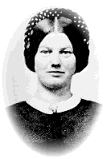 Jenny Wade (only civilian
killed)
Jenny Wade (only civilian
killed)
 Big gun
Big gun
 Young confederate
soldier
Young confederate
soldier
 Battlefield
Battlefield
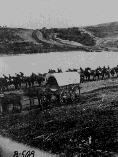 Troops on the
move
Troops on the
move
 General Grant
General Grant
 The only known
photo of Lincoln at Gettysburg
The only known
photo of Lincoln at Gettysburg

Interactive shockwave overview of battle at: http://www.icorps.com/gshock.htm
Great photos from the movie at: http://www.ronmaxwell.com/gettysburg.html
Cool hot-linked panorama at: http://www.virtualgettysburg.com/VG/prototype2.html